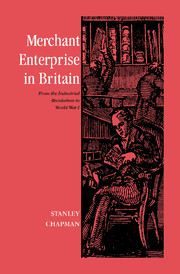Book contents
- Frontmatter
- Contents
- List of figures
- List of tables
- Preface
- Abbreviations used in the footnotes
- Introduction: approaches and concepts
- Part I The setting
- Chapter 1 The eighteenth-century structure of merchant enterprise
- Chapter 2 The consequences of the Industrial Revolution and the French Wars
- Part II New Streams Of Enterprise
- Part III Response to instant communication
- Part IV Conclusions
- Manuscript sources
- Index of firms and people
- Index of places
- Index of subjects
Chapter 1 - The eighteenth-century structure of merchant enterprise
Published online by Cambridge University Press: 20 March 2010
- Frontmatter
- Contents
- List of figures
- List of tables
- Preface
- Abbreviations used in the footnotes
- Introduction: approaches and concepts
- Part I The setting
- Chapter 1 The eighteenth-century structure of merchant enterprise
- Chapter 2 The consequences of the Industrial Revolution and the French Wars
- Part II New Streams Of Enterprise
- Part III Response to instant communication
- Part IV Conclusions
- Manuscript sources
- Index of firms and people
- Index of places
- Index of subjects
Summary
There is a large literature on British merchants and their diverse enterprises in the eighteenth century, and much academic expertise has been invested in calculating and evaluating the growing volume and value of trade in the period. If this scholarship has a limitation, it must be its parochialism, at any rate compared with Fernand Braudel's work Civilisation and Capitalism. As the focus of this book is on the changes brought by the Industrial Revolution and the age of the telegraph and rapid communication, it will only be necessary to identify the salient features of merchant activity in the earlier period, especially those that have a particular bearing on subsequent changes. The most important of these are thought to be the early emergence of merchants as an economic and social elite, the major role played by migrants from the Continent and the domination of London in the commerce of Britain, the important role played by Dissenter networks in trade, and the ways in which the high risk of overseas trade made for high turnover of firms and renewal of enterprise. Much of the research on these topics has focused on particular firms, trades, ethnic groups and ports and an attempt will be made, where possible, to evaluate the overall significance of these features.
- Type
- Chapter
- Information
- Merchant Enterprise in BritainFrom the Industrial Revolution to World War I, pp. 21 - 50Publisher: Cambridge University PressPrint publication year: 1992

